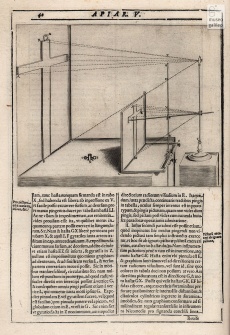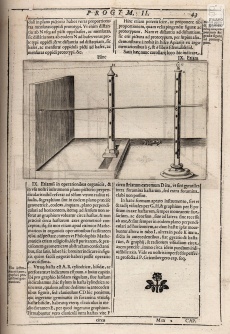Perspectograph by Mario Bettini
From Inventions
| Line 8: | Line 8: | ||
|descrizione= | |descrizione= | ||
| - | Similar in operation to the [[ | + | Similar in operation to the [[Surveying Instrument by Baldassarre Lanci |surveying instrument by Baldassarre Lanci]] and [[Scamozzi’s perspectograph]], this instrument is composed of three rods joined together, two vertical and one horizontal. The first vertical rod rests on a pedestal and terminates in a finder. The second vertical rod slides in a slot running along the edge of the drawing board and moves either sideways or up and down. The horizontal rod slides between two guides fixed to the vertical rods. The painter thus observes a point on the object to be portrayed, keeping his eye fixed on the top of the first rod. He intersects the visual ray by interposing the top of the second vertical rod between his eye and the object, and traces the intersection point on the drawing paper, pressing the horizontal rod against the drawing board with the paper on it. A similar instrument is sketched by pen in a copy of Albrecht Durer’s treatise on geometry (''Underweisung der Messung'', Nuremberg 1525) with a note in German stating: "''Ein instrument von holtz in einer viertelstund allpei perspectivisch verzeichnen lassen''", ("A wooden instrument for making a perspective drawing in a quarter of an hour"). The instrument could also be mounted coplanar with the drawing board. In this way it operated like a [[pantograph]], allowing the artist to draw from life and to copy drawings in enlarged or reduced scale. |
Revision as of 11:59, 27 July 2010
Has no specific name.
Contents |
Inventor
Mario Bettini (1584-1657)
Historic Period
1645
Description
Similar in operation to the surveying instrument by Baldassarre Lanci and Scamozzi’s perspectograph, this instrument is composed of three rods joined together, two vertical and one horizontal. The first vertical rod rests on a pedestal and terminates in a finder. The second vertical rod slides in a slot running along the edge of the drawing board and moves either sideways or up and down. The horizontal rod slides between two guides fixed to the vertical rods. The painter thus observes a point on the object to be portrayed, keeping his eye fixed on the top of the first rod. He intersects the visual ray by interposing the top of the second vertical rod between his eye and the object, and traces the intersection point on the drawing paper, pressing the horizontal rod against the drawing board with the paper on it. A similar instrument is sketched by pen in a copy of Albrecht Durer’s treatise on geometry (Underweisung der Messung, Nuremberg 1525) with a note in German stating: "Ein instrument von holtz in einer viertelstund allpei perspectivisch verzeichnen lassen", ("A wooden instrument for making a perspective drawing in a quarter of an hour"). The instrument could also be mounted coplanar with the drawing board. In this way it operated like a pantograph, allowing the artist to draw from life and to copy drawings in enlarged or reduced scale.
Bibliographical Resources
Bettini, Mario. Apiaria universae philosophiae mathematicae: in quibus paradoxa et nova pleraque machinamenta ad usus eximios traducta et facillimis demonstrationibus confirmata: opus non modo philosophis mathematicis, sed et physicis, anatomicis, militaribus viris, machinariae, musicae, poëticae, agrariae, architecturae, mercaturae professoribus etc. utilissimum, curiosissimis inventis refertum figuratum aereis formis cusarum numerosa et speciosà varietate ornatum et in duos tomos distributum, una cum gemino copiosisimo indice, altero propositionum, altero rerum: accessit ad finem secundi tomi Euclides applicatus et condítus ex apiarijs, indicatis usibus eximijs praecipuarum propositionum in prioribus sex libris Euclideorum Elementorum accessere et Analecta. Bononiae, typis Io. Baptistae Ferronij, 1645, Apiarium V, cap. IV.
Dürer, Albrecht. Underweysung der Messung mit dem Zirkel und Richtscheiyt, in Linien, Ebenen, und ganzen Corporen, H. Formschneyder (Nüremberg 1525), ed. ampliata, Nüremberg 1538, IV, fig. 58; Biblioteca Nazionale di Firenze, Palat. 13.2.6.16
Images
Author of the entry: Filippo Camerota


